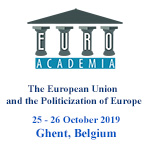Euroacademia Conferences
 Europe Inside-Out: Europe and Europeanness Exposed to Plural Observers (9th Edition) April 24 - 25, 2020
Europe Inside-Out: Europe and Europeanness Exposed to Plural Observers (9th Edition) April 24 - 25, 2020 Identities and Identifications: Politicized Uses of Collective Identities (9th Edition) June 12 - 13, 2020
Identities and Identifications: Politicized Uses of Collective Identities (9th Edition) June 12 - 13, 2020 8th Forum of Critical Studies: Asking Big Questions Again January 24 - 25, 2020
8th Forum of Critical Studies: Asking Big Questions Again January 24 - 25, 2020 Re-Inventing Eastern Europe (7th Edition) December 13 - 14, 2019
Re-Inventing Eastern Europe (7th Edition) December 13 - 14, 2019 The European Union and the Politicization of Europe (8th Edition) October 25 - 26, 2019
The European Union and the Politicization of Europe (8th Edition) October 25 - 26, 2019 Identities and Identifications: Politicized Uses of Collective Identities (8th Edition) June 28 - 29, 2019
Identities and Identifications: Politicized Uses of Collective Identities (8th Edition) June 28 - 29, 2019 The European Union and the Politicization of Europe (7th Edition) January 25 - 26, 2019
The European Union and the Politicization of Europe (7th Edition) January 25 - 26, 2019 7th Forum of Critical Studies: Asking Big Questions Again November 23 - 24, 2018
7th Forum of Critical Studies: Asking Big Questions Again November 23 - 24, 2018 Europe Inside-Out: Europe and Europeanness Exposed to Plural Observers (8th Edition) September 28 - 30, 2018
Europe Inside-Out: Europe and Europeanness Exposed to Plural Observers (8th Edition) September 28 - 30, 2018 Identities and Identifications: Politicized Uses of Collective Identities (7th Edition) June 14 - 15, 2018
Identities and Identifications: Politicized Uses of Collective Identities (7th Edition) June 14 - 15, 2018
Visibility Hierarchies: Santiago Sierra and the Homo Sacer
-
-

-
Presentation speakers
- Pedro David Massena Carreiro, Faculdade de Belas Artes, Lisbon University, Portugal
- Download presentation
Abstract:
The current article aims to assess the possibility of representing, in a visual scope, the figure of the homo sacer, a juridical term of the Roman law that the philosopher Giorgio Agamben recaptures when addressing biopolitical studies. Milena Tomic argues that any art project that addresses the issue of bare life, a condition where all the political and ethical representation was extracted by a non-mediated action of the State, must deal with its ubiquity, in the sense that Agamben sees the camp as both an anomaly of the past and the hidden matrix of the present. Tomic also argues that there is an unavoidable unrepresentability in the core of bare life, a dimension that this article aims to explore confronting it with the project of the artist Santiago Sierra who hires illegal workers, migrants or refugees in his installations and performances. The economical and ethical influence that this modus operandi creates among the figure of the homo sacer will constitute one of the axes of this paper, as well as its consequences within the process of the identity construction. The bodies selected by the artist occupy a disruptive place between subject and object, within a marginal possibility empowered by the current geo-political situation. The distribution of narcotics, between other violations of the criminal code, is punishable among the countries where the artist exhibits, operating within a political state of exception, subverting the art world, working from its character of deregulated market, structurally ambiguous and permeable. We aim, with the development of this article, to assess the political role of the art agents and institutions within the identity making process, as well as how the gestures, as the ones mentioned above, can increase or hide the visibility of the individuals trapped in transmigration areas or conflict zones.
-
Related Presentations

Does Liberalism Need a Bit of Despotism?
- Matteo Rategni













